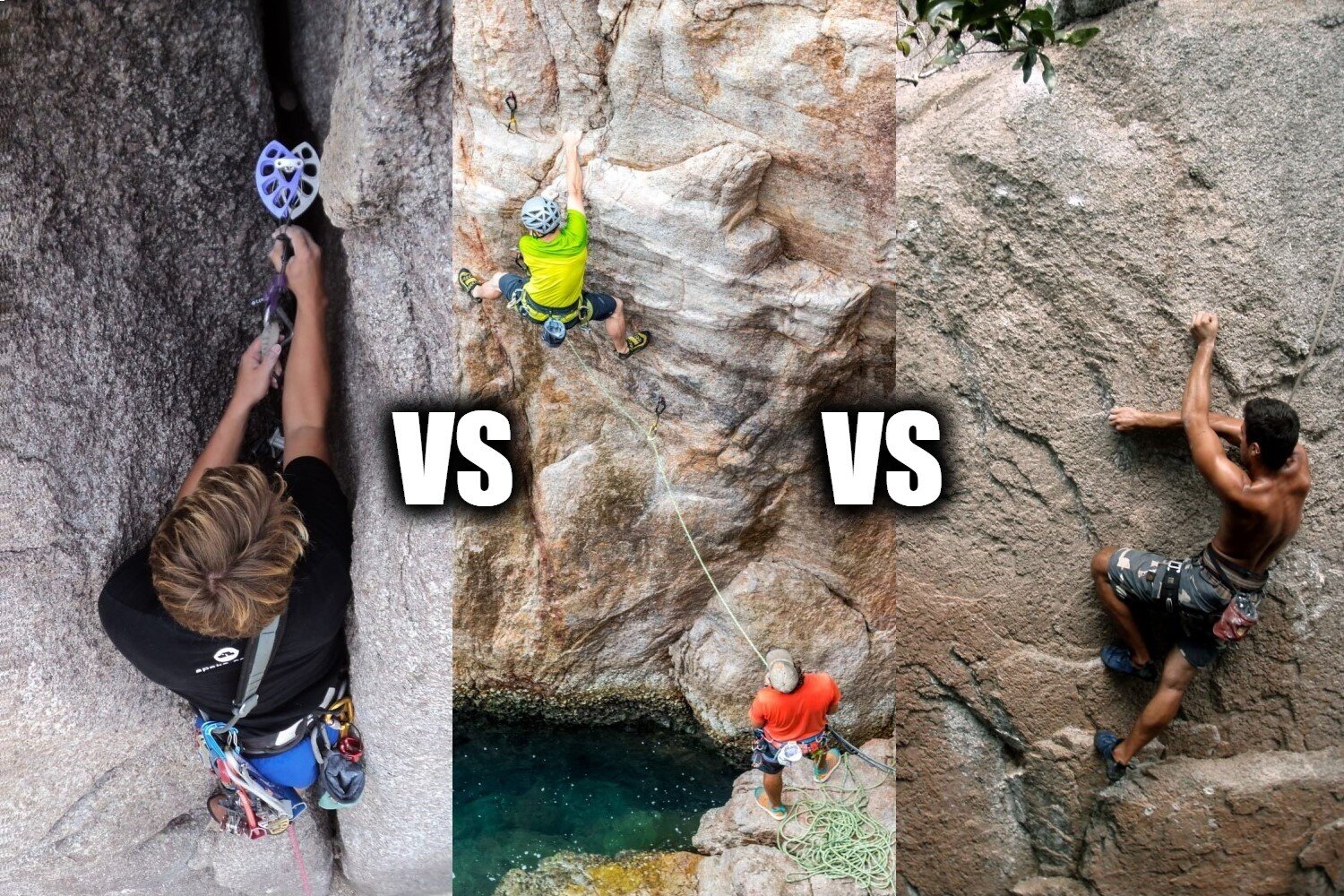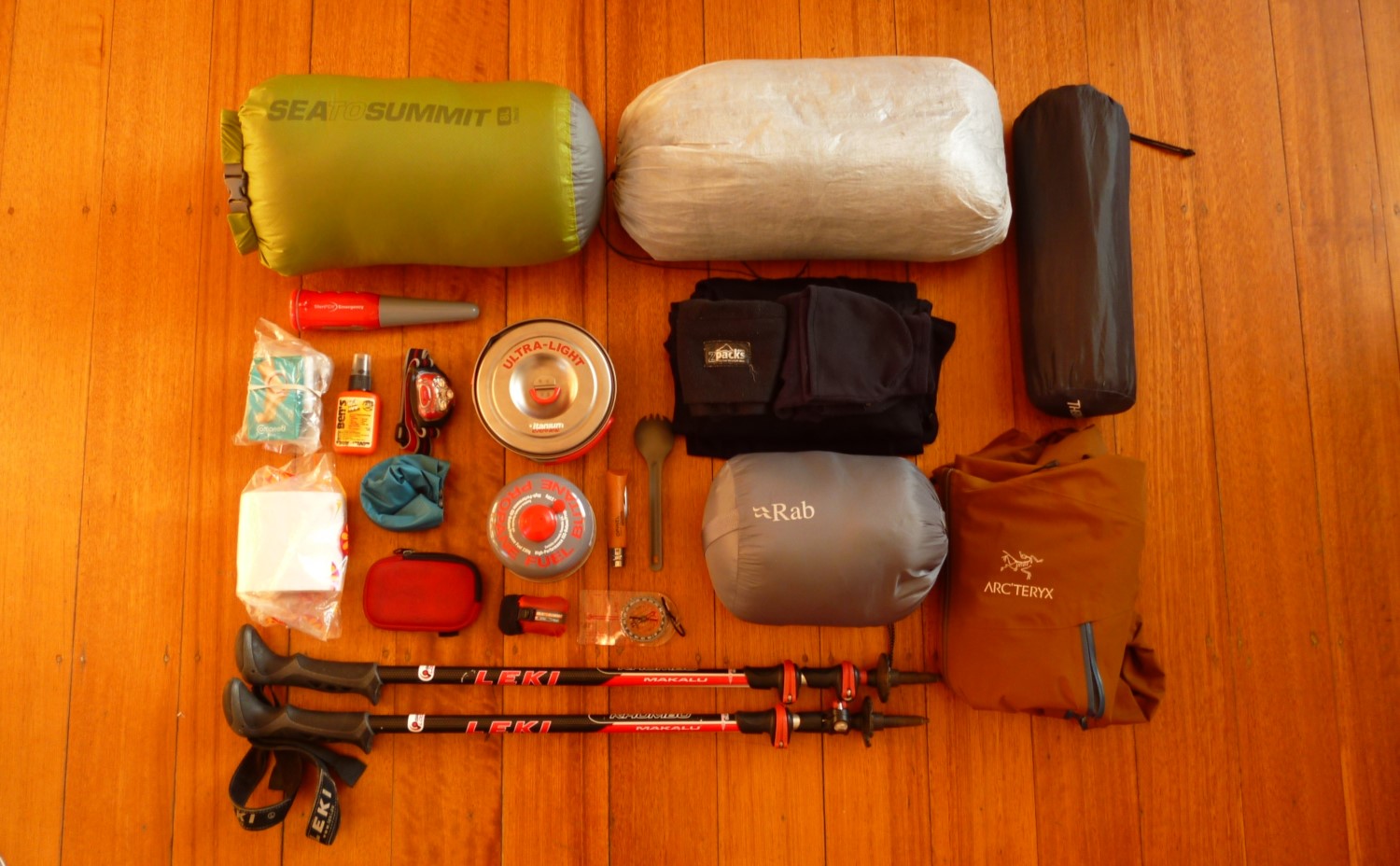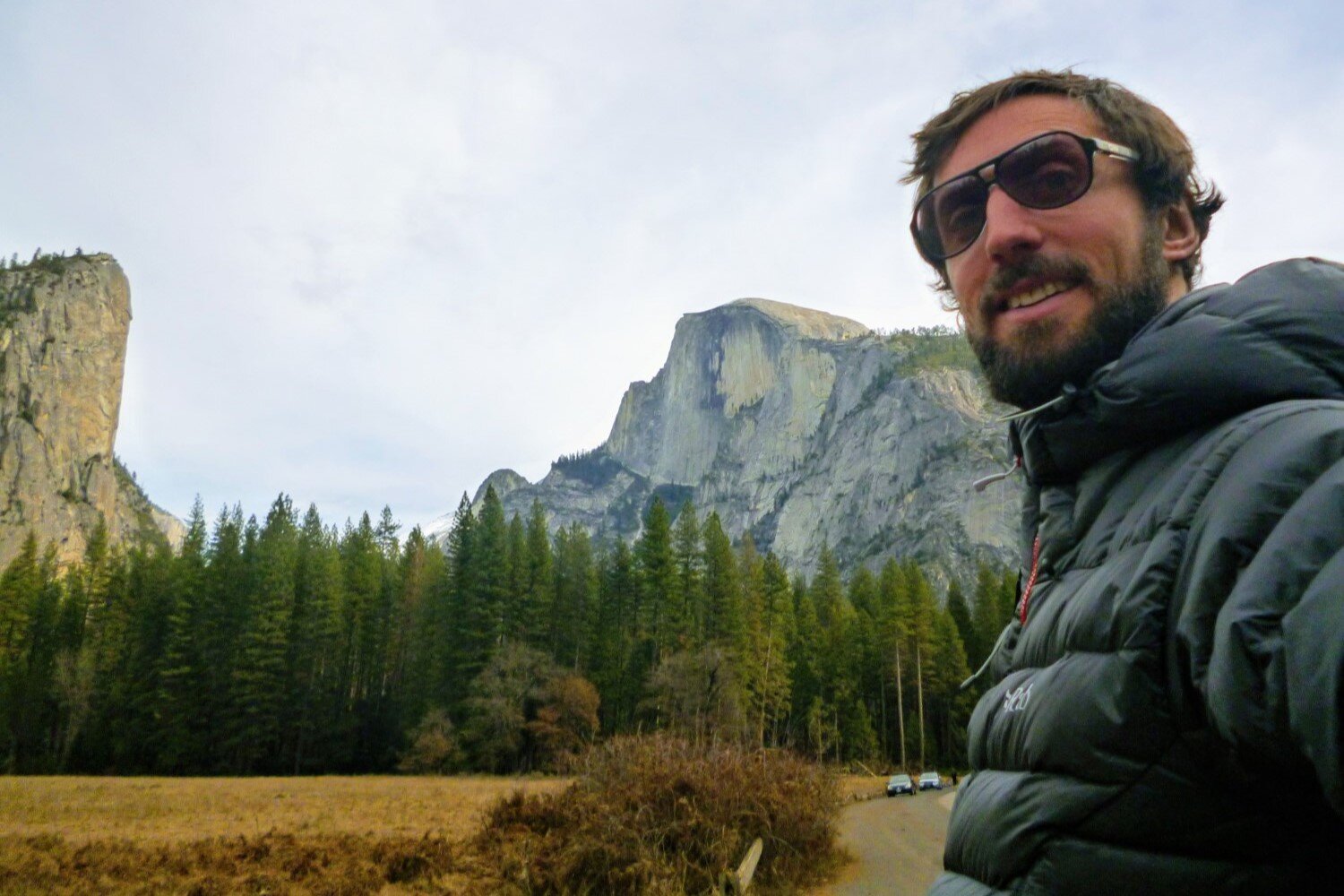Ultimate Guide to different Types of Rock Climbing
JUMP TO: BOULDERING / TOP ROPE / LEAD CLIMBING / SPORT CLIMBING / TRAD CLIMBING / MULTI-PITCH / FREE VS AID / FREE SOLOING / SUMMARY
Author: Tim Severino
When people think of rock climbing they often have a fuzzy idea of people up high, hanging from ropes in famous places like Yosemite National Park or the sea cliffs of England.
But when pushed further, they find it difficult to define all the different types of climbing that are possible.
Climbing in general – whether it be rock, trees or buildings – is an innate desire that tends to manifest when we are children. Perhaps, an evolutionary hangover from when our predecessors swung from the trees, and that we thankfully haven’t fully lost. There is a reason why so many children’s playgrounds have climbing frames for kids!
As we grow into adults, it is nature that often becomes our playground. And it is rock walls that become the ultimate climbing battle. Most people who try rock climbing tend to do so when they are teenagers, and a good percentage of people find they really enjoy it.
Top Rope is the safest form of climbing — and is almost certainly where your rock climbing journey will start…
Of course, as we get older risk versus reward calculations tend to feature more prominently in our minds than when we were kids, and many adults find rock climbing a very scary business – but with the right training and equipment it’s actually a subliminally enjoyable one.
But what are the differences between various styles of rock climbing?
In this article we give you a detailed rundown of the different types of climbing, how to access them, and the general progression a climber goes through when they learn and then continue to climb.
BOULDERING
Bouldering is a sub sport of climbing that has its origins in climbers wanting to practice moves without the need for ropes and other safety equipment, or even a partner.
HOW DOES BOULDERING WORK?
In general, bouldering encompasses doing between 2-8 moves — that are usually difficult! — to climb up and on top of a boulder.
It can be quite dangerous when performed outdoors and so most people use a large foam block, called a crash pad, and have at least one other person as a ‘spotter’ to help them when they fall and ensure they land on the pad and don’t get hurt.
WHO IS BOULDERING SUITABLE FOR?
Sounds like a fringe sport? Well it was, but now it’s one of the fastest growing sports on the planet. The main reason is that indoor bouldering is exploding in popularity – climbing gyms in cities all over the world now have bouldering walls with super thick pads beneath them on the ground. Bouldering is therefore now super accessible to almost anyone – even those with zero experience.
In the gym and with no ropes required, all you have to do it put your shoes on, chalk your hands, and climb up the wall. At the top (3-4m) you simply drop back down onto the pads.
Sounds fun? It is and it’s also a great workout and a great way to practice your moves for outdoor climbing whenever you want. Pure powerful climbing without the need for ropes!
If you do go outdoors, just make sure you are with an experienced boulderer who can make sure you are safe.
TOP ROPE CLIMBING
When it comes to going higher, where a fall could be dangerous or even fatal, we need safety equipment to make sure we are safe – and top rope climbing is as safe as it comes. Everyone starts here and no matter how far on your climbing journey you progress – you will still be “top roping” frequently.
HOW DOES TOP ROPE WORK?
Essentially we have an anchor made from stainless steel or titanium bolts drilled into the rocks and – combined with some rope or chains – this makes an unmovable and extremely strong anchor point. Don’t worry, the climbing bolts can generally take over 2 tons of force, far more than the average 70kg climber!
At this anchor, a rope is threaded through with both ends hanging down to the ground. One person – the climber – ties one end of the rope onto the harness they are wearing. Another person – the belayer – takes the rope and threads it though a belay device and carabiner attached to their harness.
The belayer can either allow the rope to move through the belay device or they can stop it moving at all by changing the position and angle of their hand. Essentially, as the climber goes up, the belayer pulls the slack rope out of the system and then puts the brake on again. If the climber falls, they only fall a little and can get back on the rocks very easily. When they reach the top, the belayer then uses the belay device to lower them back down.
WHO IS TOP ROPE SUITABLE FOR?
Sounds easy? It is when you know how. And fortunately most people can learn how to tie the required knots (and become proficient at it), how to belay, and how to climb in one day of teaching. This makes top rope climbing the perfect starting place for beginners or those who don’t like to take any excessive risks. It is also a great way to practice new moves in a safer environment.
Top rope climbing is highly accessible in indoor climbing gyms, and they often have regular courses to help you learn. Whilst outdoor top rope climbing is often taught by more dedicated climbing and adventure shops.
When done properly, top rope climbing is extremely safe and all you do as the climber – is climb!
LEAD CLIMBING
When we Top Rope, someone has to set the rope up for us. In gyms, they are pre-set, while outdoors, someone needs to find a safe way to the top before we can climb.
But what if there isn’t a safe way up? What if we want to start at the bottom and climb up safely? Welcome to lead climbing…
HOW DOES LEAD CLIMBING WORK?
In lead climbing we still have the climber and the belayer, but no top rope. Instead, there is only a rope connecting the two people.
Essentially the climber has to climb up to a point where they can make themselves safe, then keep going up past the “safe point”, and then make themselves safe at various points in the climb until they reach the top.
The safe point will either be a temporary anchor installed by the climber as they go, or a permanent (pre-installed) anchor such as a bolt –we discuss this in more detail later. To connect to the safe point the climber generally uses some equipment called a quick draw (QD).
A quickdraw is two carabiners joined by a strap — where one end goes into the safety point as you climb up and your rope goes through the other. This allows the rope to move freely, thereby allowing the belayer to still control the length of the rope, but also creates a safety point on the rock.
WHO IS LEAD CLIMBING SUITABLE FOR?
Lead climbing is obviously more dangerous than top rope climbing, as when the climber goes above their last safe point and they fall – they will fall down twice the height they are above their most recent safe point!
This means that if you are 1m above the last safe point, you will fall that meter and another 1m further below. Some quick math and you can see how dangerous it can be climbing 5-6 m above your last safety point!
So why would people take these extra risks? Well, logistically it’s far easier than top rope climbing, since there is no need to pre-set the top rope anchor. Plus, due to the risks involved, as a climber your focus is increased and there is a very real sense of achievement when you finish.
Also, if you want to climb higher – miles into the air! – you will need to take these small risks in order to get there. Whereas top rope climbing is constrained by the maximum length of the single rope.
There are two types of lead climbing:
SPORT CLIMBING: When the safety points are all pre-placed for you in the form of metal climbing bolts or slings wrapped around rocks.
TRADITIONAL CLIMBING: When you carry loads of extra equipment to make your own temporary safety points as you go.
For those itching to brave the world of lead climbing – we discuss each of these types of lead climbing in more detail below!
SPORT CLIMBING (‘SPORT’)
Sport climbing is the most popular form of climbing worldwide for people who have their own equipment and the necessary skills and experience. Most countries have climbing areas that are set up for sport climbing, which is fortunate, since most sport climbing requires the installation of permanent fixed metal bolts.
HOW DOES SPORT CLIMBING WORK?
In sport climbing, the length of the climb has metal bolts or slings wrapped around rocks every 2-5m for you to place your quick draw, and then subsequently, your rope into. If done correctly, the bolts should be placed to protect you on the more difficult moves so you don’t fall very far.
There is then a fixed anchor at the top for the climber to use to come back down again. There are different methods for retrieving your quick draws on the way back down too.
WHO IS SPORT CLIMBING SUITABLE FOR?
Most climbing gyms and every decent adventure or outdoor climbing shop offers a sport climbing course. To participate in a course, you usually require a certain level of previous climbing experience and perhaps some anchor knowledge. Then, it will be about two full days of training to reach the point where you can become independent.
The major bonus is that established climbing areas have published guides telling you where the climbs are, how high they go, how hard they are, and who put the bolts in. So if you have some equipment and a buddy, you can just climb around in your own time – sometimes for days – and at very little cost!
TRADITIONAL CLIMBING (‘TRAD’)
Sport climbing routes consist of permanent metal bolts – to help make it safe. But how did people complete those climbs before the bolts were first installed? The answer is traditional climbing, or “trad”.
HOW DOES TRAD CLIMBING WORK?
In trad climbing you carry a load of extra equipment – called a ‘trad rack’ – to make your own safe points. A trad rack consists of various shaped pieces of metal that come in many different sizes. Some are passive (they nestle into cracks in the rock) and some are active (they use springs to push back at the rock).
In a nutshell, the climber goes up until they can find a crack or a break in the rock where they can place a trad piece to use as their safe point. Generally, they will climb partway up a climb, make a temporary anchor, and then belay the other person up. The second climber then removes the pieces as they go.
Since it doesn’t depend on any preinstalled bolts, a trad climb can be any length and is instinctively what we call a multi-pitch climb.
However, the equipment is heavy and so both climbers will have extra weight. This means that people generally climb easier grades of difficulty than they would on top rope or sport climbing.
WHO IS TRAD CLIMBING SUITABLE FOR?
A standard trad rack costs over $1,000 USD usually so is an expensive starter. It is therefore usually for climbers who have progressed through the other types of climbing.
Most outdoor climbing shops should be able to offer courses that can be between 3-5 days, but due to the popularity of sport climbing, trad is not as widely done.
Having said that, there are many trad-only climbing areas around the world – and if you want to climb in those regions, then trad climbing is the only way!
MULTI-PITCH CLIMBING
Multi-pitch climbing is lead climbing – but where you just keep going up!
HOW DOES MULTI-PITCH WORK?
A “single pitch” is approximately 30m (100 ft) or lower, and is the maximum length we can top rope or lead on. The need for equipment limits the length of a single pitch – for instance, on a trad or sport route you need to be able carry your equipment for connecting to each of the safe points.
A “multi-pitch” climb is several of these single pitches – anything from 2 to 20 (or more!). The individual pitches can be sport or trad climbing, depending on your location.
WHO IS MULTI-PITCH SUITABLE FOR?
The multi-pitch nature of the climb means that it requires a lot of additional experience beyond that of single pitch lead climbing. It also requires sufficient planning – for example knowing whether you will walk off or rappel from the top, and if you need to rappel then having sufficient gear to do so.
Plus, multi-pitch climbing requires rescue skills to attempt safely – it isn’t as easy to rescue an injured climber when they cannot be lowered to the ground in one move.
But although they require significantly more experience and pose some additional risks, multi-pitch climbs can be some of the most rewarding experiences you will ever have. These climbs can last all day – or in some cases several days, requiring sleeping on a cliff edge!
FREE CLIMBING VS AID CLIMBING
FREE CLIMBING: Everything we have discussed in this article comes under the term ‘free climbing’ – which means you only use your body to climb and all the other equipment is for safety only. This contrasts with “aid climbing”.
AID CLIMBING: In aid climbing the climber uses their safety equipment or extra ropes, ladders, and slings to aid their climb. It’s usually used on extremely hard climbs or to support free climbers with food, water, etc.
FREE SOLOING
Seen the movie with Alex Honnold? If you have, then you know what free soloing is! If not, then know that this is climbing in its purest form… no safety, just you, your shoes, and a chalk bag, climbing high up the rocks until you reach the end.
Is it dangerous? Absolutely! And for that reason there are only a small group of people that do this regularly.
SUMMARY
Rock climbing is an amazing sport, with a variety of options catering to different levels of experience.
The different types of climbing might vary in their accessibility and the types of locations where they can be done – but on the whole, rock climbing is available to anyone willing to have a go. And it can be done safely and securely almost all of the time (free soloing aside!).
Whether you want to get strong bouldering, try new moves on top rope, or test your skills lead climbing – it’s a sport for all ages and abilities. And as we say when ready to climb – Climb On!
MORE INFORMATION
If you loved this article, then you'll likely love reading about some of our other outdoor adventure articles:
Or perhaps check out our Gear Reviews page or our hiking Destination Guides.
Whatever you decide, happy climbing and take care out there in the wild!






















